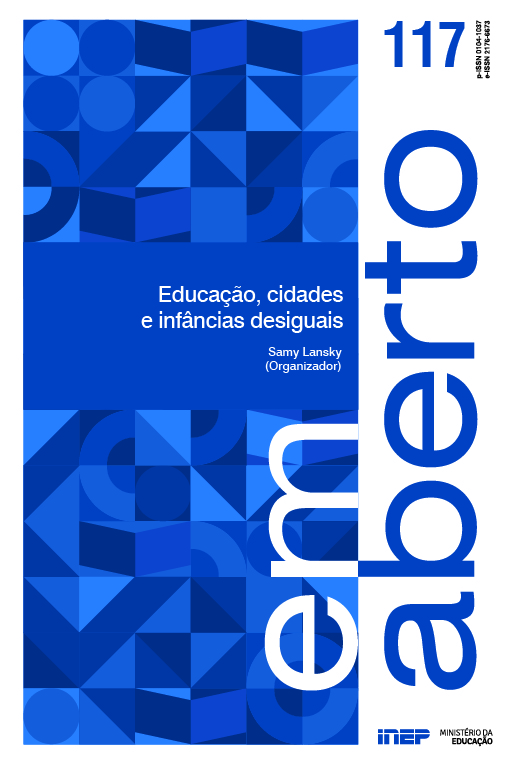Children in public recreational spaces of Fortaleza, Ceará
Abstract
Following the publication of the Municipal Plan for Early Childhood of Fortaleza (PMPIF) in 2014, the capital of the state of Ceará has been implementing urban interventions in order to meet the needs of children – such as leisure, safety and contact with nature. The theoretical framework is grounded on an analysis of the Child Friendly City concept carried out through an integrative literature review (ILR). Subsequently, an analysis of the availability of existing public recreational spaces was devised, employing georeferenced cross-sectional data of the areas with higher density of children (ages 0-12), Human Development Index (HDI) per neighborhood, as well as the number of precarious settlements and child-friendly public recreational spaces, mainly those established between 2014 and 2022. Lastly, in order to comprehend the concept of a Child Friendly City it is necessary to listen and observe children in their respective environments. Moreover, it highlights the importance of two angles: an easy unbureaucratic access to public data and the development of indicators that reveal qualitative aspects of green spaces from the children’s perspective.
Downloads
References
ALARASI, H., MARTINEZ, J., AMER, S. Children's perception of their city centre: a qualitative GIS methodological investigation in a Dutch city. Children`s Geographies, v. 14, nov.2015, p. 437-452. Acesso em: 1 maio. 2023
AMADO, J.; ALMEIDA, A.C. Políticas públicas e o direito de brincar das crianças. Laplage em Revista (Sorocaba). v. 3, n.1, jan-abr.2017, p.101-116. Disponível em: https://www.researchgate.net/publication/317127078_POLITICAS_PUBLICAS_E_DIREITO_DE_BRINCAR_DAS_CRIANCAS/fulltext/59281ff5aca27295a8052523/POLITICAS-PUBLICAS-E-DIREITO-DE-BRINCAR-DAS-CRIANCAS.pdf Acesso em: 1 maio. 2023
BOTELHO, L. L. R.; CUNHA, C. C. A.; MACEDO, M. O método da revisão integrativa nos estudos organizacionais. Gestão e Sociedade, v. 5, n. 11, p. 121-136, 2011. Disponível em: http://www.spell.org.br/documentos/ver/10515/o-metodo-da-revisao-integrativa-nos-estudos-organizacionais Acesso em: 1 maio. 2023
CHAWLA, L. Growing Up in an Urbanism World. Reino Unido: UNESCO, 2002
DIAS, M. S. Em busca dos espaços públicos de brincar: um estudo das infâncias contemporâneas na cidade de Vitória-ES. PosFAUUSP, [S. l.], v. 25, n. 45, p. 102-117, 2018. DOI: 10.11606/issn.2317-2762.v25i45p102-117. Disponível em: https://www.revistas.usp.br/posfau/article/view/111550. Acesso em: 1 maio. 2023.
FORTALEZA. Lei no 236, de 11 de agosto de 2017. Dispões sobre parcelamento, o uso e a ocupação do solo no município de Fortaleza, e adota outras providências. Diário Oficial, Fortaleza, n. 16.078, ago. de 2017. Disponível em: https://urbanismoemeioambiente.fortaleza.ce.gov.br/urbanismo-e-meio-ambiente/445-parcelamento-uso-e-ocupacao-do-solo-lei-n-236-2017 Acesso em: 1 maio. 2023.
IAB – INSTITUTO DE ARQUITETOS DO BRASIL. Guia 3: diretrizes para desenho urbano. Fundação Bernard van Leer: São Paulo, 2021.Disponível em: https://site.arbo.org.br/wp-content/uploads/2021/03/iab-guia_3-web-reduzido.pdf Acesso em: 1 maio. 2023.
IBGE – INSTITUTO BRASILEIRO DE GEOGRAFIA E ESTATÍSTICA. Censo Brasileiro de 2010. Rio de Janeiro: IBGE, 2021.
_____. Projeções da população: Brasil e unidades da federação. Rio de Janeiro: IBGE, 2018
JAMES, A, JAMES, A. Constructing childhood: theory, policy and practice Palgrave Macmillan, Basingstoke. Londres: Palgrave Macmillan, 2004.
LIMA, M.S. A Cidade e a Criança. Coleção Cidade Aberta. São Paulo: Nobel, 1989.
LYNCH, K. Growing Up in Cities. London: The MIT Press and UNESCO. 1977.
MARSI, S.S. Integrating youth in city planning: Developing a participatory tool toward a child-friendly vision of Eastern Wastani – Saida. Alexandria Engineering Journal, v. 57, n. 2, fev.2017, pp. 897-909. Acesso em: 1 maio. 2023.
NÓBREGA, A. C.; SILVA, A.A.B.; CIDRÃO, T.V. Os assentamentos precários em Fortaleza: um breve panorama da qualidade de vida dos excluídos. Revista de Direito da Cidade, v.13, n.2, p.1023-1051, 2021. Disponível em: https://www.e-publicacoes.uerj.br/index.php/rdc/article/view/64644/41047 Acesso em: 1 maio. 2023.
PITSIKALI, A. PARNELL, R. MCINTYRE, L. The Public value of child-friendly space. Reconceptualising the playground. Archnet-IJAR: International Journal of Architectural Research v. 14, n. 2, 2020. p. 149-165 DOI 10.1108/ARCH-07-2019-0164. Acesso em: 1 maio. 2023.
QUEIROZ, D. de A. H. de O.; CARVALHO, S. M. Avaliação da qualidade das áreas verdes urbanas de Ponta Grossa, PR, Brasil. Terr@ Plural, [S. l.], v. 13, n. 3, p. 217–236, 2019. Disponível em: https://revistas.uepg.br/index.php/tp/article/view/13451. Acesso em: 1 maio. 2023.
SARMENTO, M. J. Infância e cidade: restrições e possibilidades. Revista Educação, v. 41, n. 2, p. 232-240, maio-ago, 2018.
SHONKOFF, J. P. Filme O Começo da Vida. Direção: Estela Renner. Produção: Maria Farinha Filmes, 2016. (120 min.).
TISSOT, K.N.S de A. A CRIANÇA E A CIDADE: Percepções e rememorações infantis sobre Pelotas (RS). Interespaço - Revista de Geografia e Interdiscipplinaridade. Rejaú/MA, v. 2, n. 6, p. 33-59, maio/ago. 2016. Acesso em: 21/05/2021.
UNICEF – UNITED NATIONS CHILDREN’S FUND. Child friendly cities and communities handbook, 2004. Disponível em: https://www.unicef.org/eap/reports/child-friendly-cities-and-communities-handbook. Acesso em: 1 maio. 2023.

This work is licensed under a Creative Commons Attribution-NonCommercial 4.0 International License.
These are the terms of this Copyright Notice:
- I declare that I permanently forfeit in favor of the National Institute of Educational Studies and Research (INEP) all rights related to:
-
- editing, publication, reproduction, and distribution of the work;
- publication through digital and electronic media;
- translation of the work to any language;
- updating, re-printing, adaptation, and compression of the work;
- uploading of work in the publishing platform of INEP;
- divulging complete or parts of work through the World Wide Web (internet), whether in Brazil or foreign countries;
- authorization of third parties to execute any of the acts mentioned before.
- I explicitly declare that I am solely responsible for the opinions expressed in the work, and its publication does not violate the rights of third parties.
- I declare that the nature of said work is one of pro bono publico and, as such, I forfeit the right to any compensation regarding ownership rights granted.
- I authorize spelling and grammatical review of the manuscript, provided that the content and opinions therein remain unchanged.












